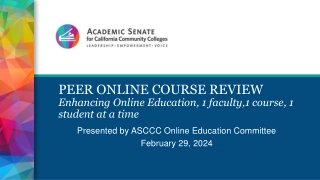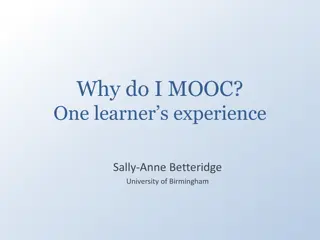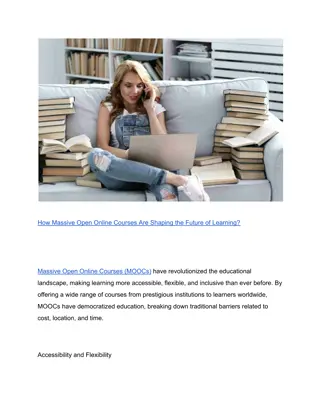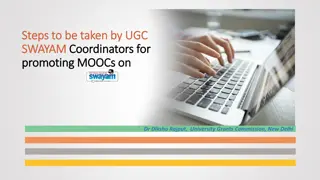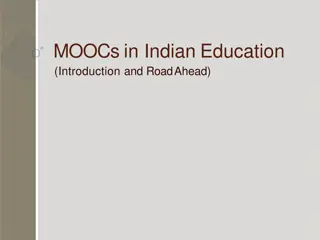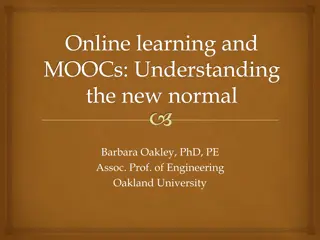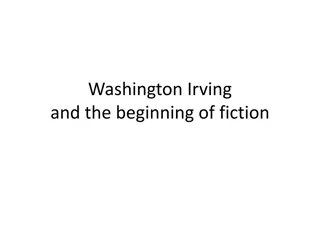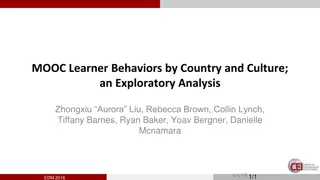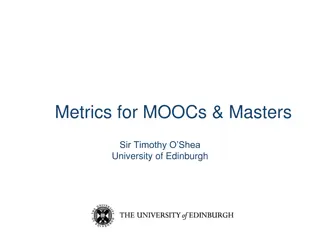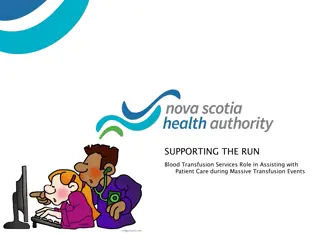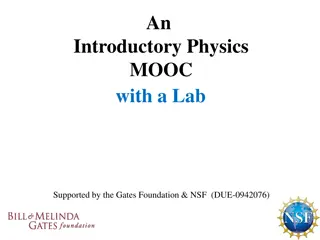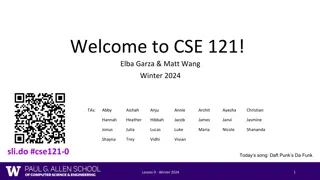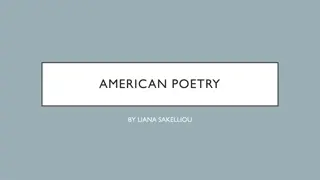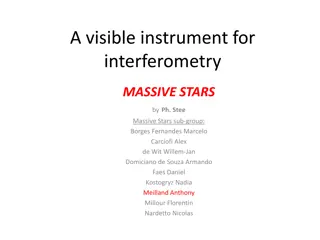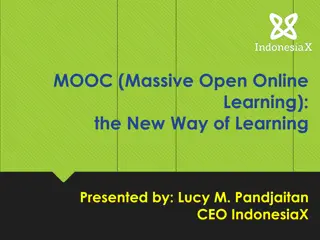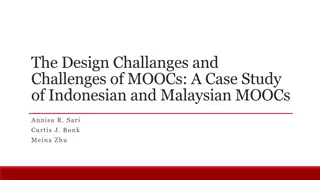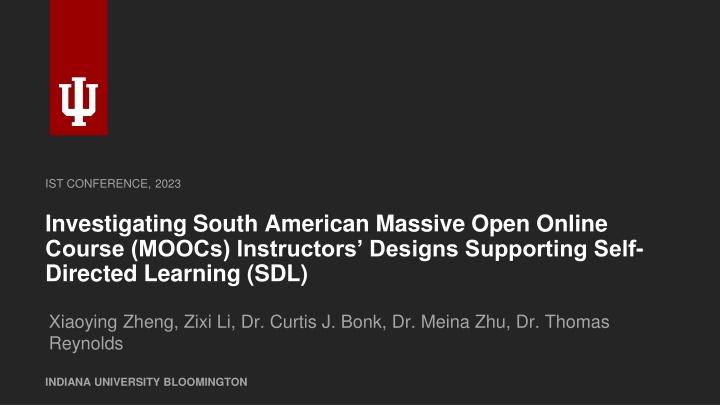
Investigating South American Massive Open Online Course (MOOCs) Instructors Designs Supporting Self-Directed Learning
This research study explores how MOOC instructors in South America design courses to support self-directed learning. It delves into the unique aspects of MOOC learning, emphasizing the essential role of self-directed learning skills for successful outcomes. The literature review covers various models and perspectives on self-directed learning, highlighting the criticality of motivation in MOOC learning environments.
Download Presentation

Please find below an Image/Link to download the presentation.
The content on the website is provided AS IS for your information and personal use only. It may not be sold, licensed, or shared on other websites without obtaining consent from the author. If you encounter any issues during the download, it is possible that the publisher has removed the file from their server.
You are allowed to download the files provided on this website for personal or commercial use, subject to the condition that they are used lawfully. All files are the property of their respective owners.
The content on the website is provided AS IS for your information and personal use only. It may not be sold, licensed, or shared on other websites without obtaining consent from the author.
E N D
Presentation Transcript
IST CONFERENCE, 2023 Investigating South American Massive Open Online Course (MOOCs) Instructors Designs Supporting Self- Directed Learning (SDL) Xiaoying Zheng, Zixi Li, Dr. Curtis J. Bonk, Dr. Meina Zhu, Dr. Thomas Reynolds INDIANA UNIVERSITY BLOOMINGTON
SECTION 1 Context
CONTEXT Massive Open Online Course (MOOCs) (Sharples,M., 2019) INDIANA UNIVERSITY BLOOMINGTON
CONTEXT MOOCs Development MOOCs have an impact on large population. (Stewart, 2013, p. 236) Online and blended learning expanded since the 20th century. (Bonk et. al, 2020) INDIANA UNIVERSITY BLOOMINGTON
CONTEXT MOOCs Learning MOOC learning significantly differs from traditional classroom learning regarding the roles and duties of both instructors and learners. Successful MOOCs learning requires self-directed learning (SDL) skills ( Zhu et al., 2020; Kim et al., 2021). INDIANA UNIVERSITY BLOOMINGTON
SECTION 2 Literature Review
Self-Directed Learning (SDL) LITERATURE REVIEW Self-directed learning (SDL) refers to a type of learning where individuals are in charge of the planning, implementation, and assessment of one s own learning process, which is a critical ability in the learning environments of this new learning age, which are often informal, online, and open (Bonk, 2009, 2020; Hiemstra, 1994; Loyens et al., 2008). Various models and views on SDL have emerged over the years. Candy (1991), Brockett and Hiemstra (1991), and Garrison (1997) were among the most frequently cited and comprehensive SDL models (Song and Hill, 2007). INDIANA UNIVERSITY BLOOMINGTON
Self-Directed Learning (SDL) LITERATURE REVIEW Garrison (1997) included a new SDL perspective, namely, motivation, which is especially relevant when attempting to learn from MOOCs because many studies have reported that motivation played an important role in MOOC learning through conceptualization, engagement, commitment, and strategies (Hew & Cheung, 2014; Littlejohn et al., 2016; Romero-Fras et al., 2020; Zheng et al., 2015). INDIANA UNIVERSITY BLOOMINGTON
LITERATURE REVIEW Garrison s (1997) SDL Framework 1. Self-management refers to the ability of task control, including goal setting and the management of time, resources, and support. 2. Self-monitoring refers to the cognitive and metacognitive process to construct learning approaches and strategies while setting the learning pace. 3. Motivation refers to both entering motivation and task motivation, which can initiate and sustain learning efforts towards cognitive goals. INDIANA UNIVERSITY BLOOMINGTON
LITERATURE REVIEW MOOCs & SDL 1. MOOC learning significantly differs from traditional classroom learning regarding the roles and duties of both instructors and learners. (Zhu et al., 2020) 2. Successful MOOC learning requires self-directed learning (SDL) skills (Kim et al., 2021; Zhu et al., 2020). 3. As the opportunities to learn from free and open online resources have become increasingly common, there has been increased research interest in self-regulated learning (SRL) and SDL when accessing MOOCs (Alonso-Menc a et al., 2020). INDIANA UNIVERSITY BLOOMINGTON
LITERATURE REVIEW Research Gap 1. Less than 1% of the scientific literature on MOOCs has been centered in the South American region (Veletsianos & Shepherdson, 2016). 2. Existing research on MOOCs in South America has primarily employed quantitative research methods (S nchez & Reyes-Rojas, 2019; Veletsianos & Shepherdson, 2016; Zhu, Sari, & Bonk, 2018). 3. While the majority of MOOCs research focused on students learning, recent research indicated that designing MOOCs is challenging for instructors because of MOOCs massiveness and openness (Sari et al., 2020). INDIANA UNIVERSITY BLOOMINGTON
LITERATURE REVIEW Research Questions 1. What strategies do MOOCs instructors in South America use to facilitate learners self-management skills, such as goal setting, time, and resource management? 2. What strategies do instructors use to support learners self-monitor skills, such as self-evaluating learning and monitoring process? 3. What strategies do instructors use to maintain learners motivation? 4. What are some frustrations and challenges when they design MOOCs? INDIANA UNIVERSITY BLOOMINGTON
SECTION 3 Method
METHOD Overview A qualitative method was used to fill in the research gap. Convenient sampling was applied. Individual interviews were conducted with 11 MOOCs instructors. Thematic analysis was used to analyze the data. The data analysis process is still ongoing. INDIANA UNIVERSITY BLOOMINGTON
METHOD Participants Recruitment 1. 366 MOOCs instructors from institutions located in South America were identified from major MOOCs websites (i.e., Coursera, EdX, FutureLearn). 2. A bilingual survey in English and Spanish was distributed through emails to these instructors to collect demographic information, understanding towards SDL, and screen participants. 3. The criteria for selecting these participants were that they should have designed at least one MOOC. 4. 44 survey responses were collected, and 11 instructors accepted for the interview invitation. INDIANA UNIVERSITY BLOOMINGTON
METHOD Participants Demographics Name Gender Country # of MOOCs taught Alejandro Male Colombia 1 Bruno Male Argentina more than 5 Male Colombia 2 Christopher Daniela Female Colombia 1 Echa Female Colombia 2 Felipe Male Brazil 1 Gavino Male Colombia 2 Hern n Male Brazil 4 Ignacio Male Colombia 1 Jorge Male Chile 3 Keiman Male Chile 1
METHOD Instrument 1. The interview instrument was adapted from the Zhu et al. (2019, 2020) study, which investigated MOOC instructors' practices to facilitate student SDL, which was based on Garrison's (1997) conceptual framework. 2. The semi-structured interview protocol included: The consent information Interviewees demographic questions Questions about instructors perception of SDL and open education Questions about specific perspectives of SDL based on Garrison (1997) Questions about instructors professional development needs INDIANA UNIVERSITY BLOOMINGTON
METHOD Interview Protocol Sample What types of support do you receive from your home institutions? Is there a team facilitating your MOOCs design? Question 2 What do you think of the responsibility of instructors to facilitate students SDL skills in MOOCs? Question 4 How do you think the design and delivery of your MOOC can help develop students self-management skills such as time, resources, and support? Could you please give me a specific example in designing or developing your MOOC that might have had a direct or indirect impact on these skills? Question 5 INDIANA UNIVERSITY BLOOMINGTON
METHOD Data Analysis 1. All interviews were conducted and video recorded through Zoom. 2. Thematic analysis (Braun & Clarke, 2006) are used for data analysis. 3. After the researchers reviewed the transcriptions to improve the accuracy, member check is applied to further increase the accuracy. 4. Data are coded through NVivo 12. 5. Data analysis is still ongoing at this moment. INDIANA UNIVERSITY BLOOMINGTON
SECTION 4 Tentative Findings
TENTATIVE FINDINGS Self-Management Key finding #1: The most common way to support self-management is breaking down a long video (e.g., 30 mins) into short videos (e.g., 5 mins). Quote 1: Shorter videos instead of longer videos is better because you can ask questions about the specific topic, not the 30 minutes talking to the camera. (Bruno) Quote 2: If you do videos that are 20 min long, that's sad, but they are not going to last. If you do 5 videos of 3 minutes each, in comparison to one of 20 minutes, or something like that, it's gonna be different. (Echa) INDIANA UNIVERSITY BLOOMINGTON
TENTATIVE FINDINGS Self-Management Key finding #2: Many of them did not help with goal setting for students, but said students to do so. About half of them mentioned writing clear learning objectives is important so that students know what to expect and give students directions. Quote: No, I definitely did not design the MOOC with that in mind. And I guess within class, it s very seldom that you find the student that wants to go beyond the core class requirements .I should incorporate complimentary MOOCs that they like to take to direct them to online material that might be of their interests. (Keiman) INDIANA UNIVERSITY BLOOMINGTON
TENTATIVE FINDINGS Self-Monitoring Key finding: Reflection questions, progress bar that shows completion, quizzes, and peer-to-peer evaluations, and forums are designed for students to self-monitor their learning. Quote 1: ...progress bars, like a roadmap, of course, completion. So you know where you are in each way you can saw. Yes, I think most of those tools we have. (Felipe) Quote 2: Oh, in terms of monitoring their learning, what we have is a single material. I have a quiz associated with it, and they only progress in the course if they felt 80% of the quiz correct. (Hern n) INDIANA UNIVERSITY BLOOMINGTON
TENTATIVE FINDINGS Motivation Key finding: About half of the interviewees mentioned that they make efforts to motivate students by designing interactive elements (e.g., peer-to-peer interaction, pop-out quizzes in the video), but the gamification features are limited. Quote 1: They started like, okay, did you know that? And you needed to click (the answers) in order to let it (the feedback) pop out, and then get more information .They made it definitely more interactive than just a reading a book or an article. (Alejandro) Quote 2: We manage motivation with a lot of visual aids, just like dynamics, not like try to make like short videos, show something to make a question, something have to interact and come back and give answer to the question, see if you felt it right or not. (Daniela) INDIANA UNIVERSITY BLOOMINGTON
TENTATIVE FINDINGS Professional Development Key finding: Almost all the teachers received a certain level of training or facilitation from their home institutions on editing videos. They indicated that working in a team with instructional designers or technicians is crucial. Quote 1: The university has a recording studio, with two employees working there. They recorded the video and did small editing, so that s a very good support. (Hern n) Quote 2: I had a lot of supports on the recordings, and tutoring my materials of my actual physical course, and then like how to translate the specific activities to make it adapt to MOOCs. (Jorge) INDIANA UNIVERSITY BLOOMINGTON
TENTATIVE FINDINGS Interesting Perspectives 1. Students need to feel the content is relevant to their life can be motivated, which aligns with previous studies on major motivations to take MOOCs. 2. Some instructors collaborate with European instructors to teach MOOCs, teaching styles differ from South American styles and so need students to adapt. 3. Some South-American-based MOOCs platforms are more adapted to their culture (e.g., aesthetic, gamification features). One instructor mentioned he felt lonely because not many people in South America worked on designing MOOCs and he could not find more accessible support when designing MOOCs. INDIANA UNIVERSITY BLOOMINGTON
SECTION 5 Significance of Study
SIGNIFICANCE Fill in Research Gaps Few scientific literature on MOOCs has been centered in the South American region. Existing research on MOOCs in South America has primarily employed quantitative research methods In addition to the students learning, designing MOOCs is challenging for instructors because of MOOCs massiveness and openness. INDIANA UNIVERSITY BLOOMINGTON
SIGNIFICANCE Possible Implementations In addition, the findings should impact on the design and delivery of courses that affect millions of students in practice. A critical impact of this study is to provide institution leaders with the insights of carrying out MOOCs projects, especially focusing on providing professional development support for MOOCs instructors. INDIANA UNIVERSITY BLOOMINGTON
SECTION 6 Limitations
LIMITATIONS Samples Convenient sampling was used. Given that the response rate is low, there is a limited number of participants that we were able to access and reach to. - We had almost a half of the participants came from Colombia and the other half from Argentina, Brazil, anc Chile. - We also had only two female participants and nine male participants. Demographic information may influence their perception towards our research questions. Therefore, any generalization of the findings from this study to other settings might be cautious, at best. INDIANA UNIVERSITY BLOOMINGTON
LIMITATIONS Participants Participants were voluntary. The instructors who volunteered to participate in this study could have had higher awareness and motivation to design and deliver MOOCs to facilitate SDL skills than the others who did not participate in the study. As such, the findings of the study may have volunteer bias. INDIANA UNIVERSITY BLOOMINGTON
LIMITATIONS Data Source Only a single data source. The study relied on self-reported interview data. Future research could expand to additional data sources and methodologies. INDIANA UNIVERSITY BLOOMINGTON
SECTION 7 Q & A
SECTION 8 References
REFERENCES Alonso-Menc a, M. E., Alario-Hoyos, C., Maldonado-Mahauad, J., Est vez-Ayres, I., P rez-Sanagust n, M., & Delgado Kloos, C. (2020). Self-regulated learning in MOOCs: lessons learned from a literature review. Educational Review, 72(3), 319-345. Bonk, C. J. (2009). The World is Open: How Web Technology is Revolutionizing Education. San Francisco, CA: Jossey-Bass. Bonk, C. J. (2020). Pandemic ponderings, 30 years to today: Synchronous signals, saviors, or survivors? Distance Education, 41(4), 589- 599. https://doi.org/10.1080/01587919.2020.1821610 Bonk, C. J., & Zhu, M. (Eds.). (2022). Transformative Teaching Around the World: Stories of Cultural Impact, Technology Integration, and Innovative Pedagogy. Routledge. Braun, V., & Clarke, V. (2006). Using thematic analysis in psychology. Qualitative research in psychology, 3(2), 77-101. Garrison, D. R. (1997). Self-directed learning: Toward a comprehensive model. Adult education quarterly, 48(1), 18-33. Hiemstra, R. (1994). Self-directed learning. IACE Hall of Fame Repository. Kim, D., Jung, E., Yoon, M., Chang, Y., Park, S., Kim, D., & Demir, F. (2021). Exploring the structural relationships between course design factors, learner commitment, self-directed learning, and intentions for further learning in a self-paced MOOC. Computers & Education, 166, 104171. Littlejohn, A., Hood, N., Milligan, C., & Mustain, P. (2016). Learning in MOOCs: Motivations and self-regulated learning in MOOCs. The Internet and Higher Education, 29, 40-48. Loyens, S. M., Magda, J., & Rikers, R. M. (2008). Self-directed learning in problem-based learning and its relationships with self-regulated learning. Educational Psychology Review, 20(4), 411-427. Romero-Fr as, E., Arquero, J. L., & del Barrio-Garc a, S. (2020). Exploring how student motivation relates to acceptance and participation in MOOCs. Interactive Learning Environments, 1-17. S nchez, J., & Reyes-Rojas, J. (2020). Trends and Issues. In Zhang, K., Bonk, C. J., Reeves, T. C., & Reynolds, T. H. (Eds.), MOOCs and open education in the Global South: Challenges, successes, and opportunities. NY: Routledge. Sari, A. R., Bonk, C. J., & Zhu, M. (2020). MOOC instructor designs and challenges: what can be learned from existing MOOCs in Indonesia and Malaysia?. Asia Pacific Education Review, 21(1), 143-166. INDIANA UNIVERSITY BLOOMINGTON
REFERENCES Sharples, M. 2019. Visions for the Future of Educational Technology. In: Ferguson, R., Jones, A. and Scanlon, E. (eds). Educational Visions: Lessons from 40 years of innovation. Pp. 151 166. London: Ubiquity Press. DOI: https://doi.org/10.5334/bcg.j. License: CC-BY 4.0 Song, L., & Hill, J. R. (2007). A conceptual model for understanding self-directed learning in online environments. Journal of Interactive Online Learning, 6(1), 27-42. Stewart, B. (2013, June). Massiveness + Openness = New Literacies of Participation? IslandScholar | Robertson Library. https://www.islandscholar.ca/islandora/object/ir%3A153 Veletsianos, G., & Shepherdson, P. (2016). A systematic analysis and synthesis of the empirical MOOC literature published in 2013 2015. The International Review of Research in Open and Distributed Learning, 17(2), 1 17. Retrieved from https://files.eric.ed.gov/fulltext/EJ1093662.pdf Zheng, S., Rosson, M. B., Shih, P. C., & Carroll, J. M. (2015, February). Understanding student motivation, behaviors and perceptions in MOOCs. In Proceedings of the 18th ACM conference on computer supported cooperative work & social computing (pp. 1882-1895). Zhu, M., Sari, A., & Bonk, C. (2018, June). A systematic review of MOOC research methods and topics: Comparing 2014 2016 and 2016 2017. Proceedings of EdMedia 2018: World Conference on Educational Media and Technology (pp. 1676 1685). Association for the Advancement of Computing in Education (AACE), Amsterdam, Netherlands. Zhu, M., & Bonk, C. J. (2019). Designing MOOCs to facilitate participant self-monitoring for self-directed learning. Online Learning, 23(4), 106-134. Zhu, M., Bonk, C. J., & Doo, M. Y. (2020). Self-directed learning in MOOCs: Exploring the relationships among motivation, self-monitoring, and self- management. Educational Technology Research and Development, 68(5), 2073-2093. https://doi.org/10.1007/s11423-020-09747-8 INDIANA UNIVERSITY BLOOMINGTON

